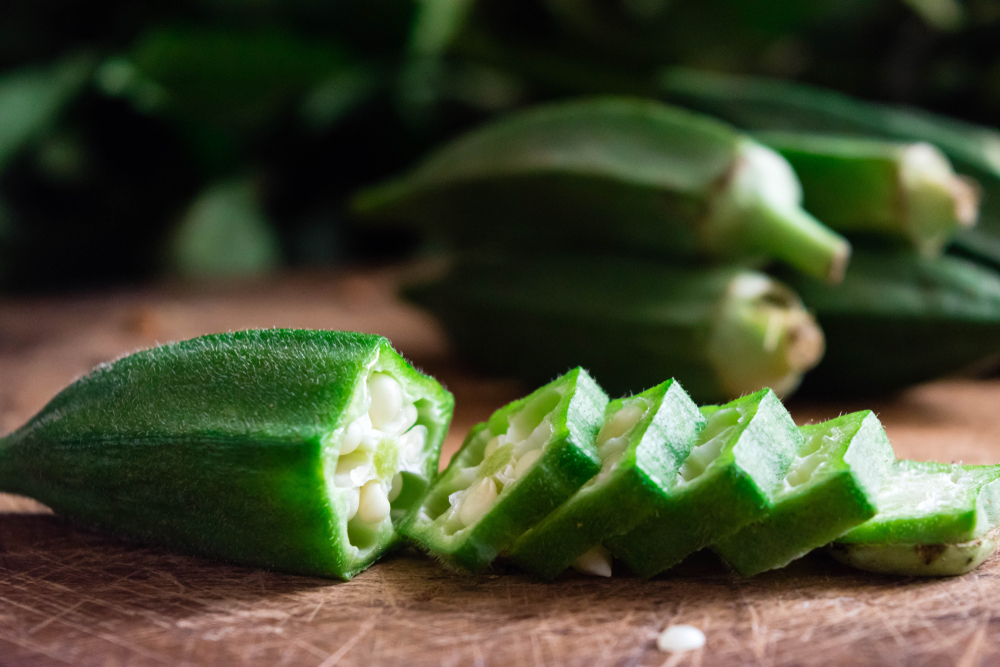Gumbo, a traditional Louisiana dish, is known for its rich flavors and unique combination of ingredients. One of its essential components is okra, which acts as a natural thickening agent and adds a distinctive taste to the dish.
However, there are times when okra may not be readily available, or some people might prefer an alternative due to personal preferences or dietary restrictions.
In such cases, finding the best substitute for okra in gumbo becomes crucial.
To choose the right okra substitute, it’s necessary to understand the key characteristics that make okra valuable in gumbo. These include its thickening ability, texture, and flavor profile.
With this knowledge, we can explore various vegetable options, common thickening alternatives, and additional ingredients that can mimic or replace the role of okra while maintaining the authentic taste of gumbo.
Key Takeaways
- Explore vegetable options and thickening alternatives to replace okra in gumbo
- Consider integrating meats, fish, lentils, and spices for additional flavor
- Understand the importance of okra’s characteristics in choosing the best substitute
Understanding Okra’s Role in Gumbo

Okra has a long-standing role in traditional gumbo recipes, which have their roots in Louisiana and the Southern United States.
Gumbo, with its rich history, is a melting pot of flavors influenced by West African, French, Spanish, and Native American cuisines. Okra, a key component of this dish, was initially introduced to the region by West African slaves.
In gumbo, okra serves multiple functions. First and foremost, it acts as a natural thickening agent, due to its slimy texture when cooked.
This sliminess, known as “mucilage,” helps to create the desired consistency for the stew-like dish. Okra’s distinctive flavor also adds to gumbo’s overall taste profile, providing depth and complexity to the other ingredients.
In addition to its thickening properties and unique taste, okra has a cultural significance in gumbo. The dish’s name itself is derived from the West African word for okra, “ki ngombo” or “gombo”, emphasizing its foundational role in the recipe.
While the use of okra is traditional in many gumbo recipes, there are regional variations throughout Louisiana and the Southern United States.
Some areas, such as those with Cajun influences, often utilize alternatives like filé powder or roux to thicken their gumbo. However, okra remains an important and authentic ingredient for many gumbo enthusiasts.
In summary, okra plays a crucial part in gumbo’s history and preparation, contributing not only to the dish’s consistency and flavor but also to its cultural origins.
The Key Characteristics of an Ideal Okra Substitute
An ideal okra substitute should possess similar characteristics to okra, allowing it to seamlessly blend into gumbo recipes without compromising the dish. The key factors to consider are texture, thickening properties, and flavoring.
Texture is essential when choosing a substitute for okra, as it contributes to the overall mouthfeel and consistency of the gumbo. Okra has a unique slimy texture which is a result of its mucilage content.
A suitable substitute should mimic this texture or provide an alternative that is complementary to the rest of the dish.
Thickening properties are another important aspect of an ideal okra substitute. Okra is known for its natural ability to act as a thickening agent in gumbo, creating the hearty, rich consistency that is characteristic of the dish.
A good substitute should also provide thickening effects while maintaining a balanced flavor profile.
Flavoring is the final key characteristic to consider in a substitute for okra. Okra has a distinct, slightly earthy taste that adds depth to gumbo dishes.
When selecting a substitute, it should have a flavor that complements the dish without overpowering the other ingredients.
Some possible okra substitutes that exhibit these key characteristics include:
- Slippery Elm: This plant’s inner bark can provide a similar texture to okra due to its mucilage content. Its mild flavor allows it to blend well with the other gumbo ingredients.
- File powder: Made from ground sassafras leaves, file powder acts as a thickening agent and adds a mild, earthy flavor to the gumbo. However, it lacks the slimy texture of okra, so it is recommended to combine it with another texturally similar ingredient.
- Gombo: Also known as jute leaves or saluyot, gombo is a leafy green that has similar thickening properties to okra. It can be used fresh or dried and provides a similar texture to the dish.
When selecting an ideal okra substitute, it is essential to weigh the importance of texture, thickening properties, and flavoring for your specific gumbo recipe.
By considering these key characteristics, you can successfully incorporate a suitable substitute for okra without compromising the overall taste and consistency of your gumbo dish.
Vegetable Options as Okra Substitutes

When it comes to finding a suitable substitute for okra in gumbo, there are several vegetables that can fill the void left by this unique ingredient.
Each alternative offers a different texture and flavor, so experiment with these options to find the perfect fit for your gumbo recipe.
Eggplant is a versatile choice that absorbs the flavors of gumbo well and provides a similar texture to okra. Select firm, ripe eggplants and dice them into small pieces for an ideal okra substitute.
Eggplants can also assist in thickening the gumbo, just like okra does.
Green beans can be another option to replace okra, adding a satisfying crunch to your gumbo. Cut them into bite-sized pieces and slightly cook them before adding to the dish.
Though they don’t provide the same thickening effect as okra, green beans introduce a delightful texture and color contrast.
Zucchini is a popular choice for many gumbo enthusiasts when okra is not available. Its mild flavor easily adapts to the gumbo spices, and the texture is fairly similar to that of okra. Dice the zucchini into small cubes for the best results.
Asparagus may not be an obvious choice, but its earthy flavor and firm texture make it a surprising contender for an okra substitute.
Cut the asparagus into bite-sized pieces and cook them lightly before adding to the gumbo. Keep in mind that asparagus has a strong flavor, so it may be best to combine it with other vegetables.
Nopales, or cactus pads, are an unconventional but fitting okra substitute. They contain a slimy texture similar to okra and a distinct taste that lends well to gumbo dishes.
Nopales should be well-cooked before adding to your recipes.
Broccoli florets can also be used as an okra substitute in gumbo. They bring a unique and tasty twist to the dish and provide a delightful, crunchy texture.
Blanch the broccoli florets before adding them to the gumbo to preserve their vibrant color and crispness.
In conclusion, there are various vegetable options available when it comes to substituting okra in gumbo.
Test these alternatives to discover the perfect substitute that complements your gumbo and satisfies your taste buds.
Common Thickening Alternatives for Gumbo
When looking for a substitute for okra in gumbo, it’s important to consider other thickening agents that can provide a similar consistency without altering the flavor too much.
Here are some common alternatives that can be used as thickening agents in gumbo:
Roux: This is a traditional thickening method used in gumbo recipes. It’s made by cooking flour and fat (usually butter) together until they form a paste.
Roux provides a rich, nutty flavor and can be made in varying degrees of darkness, depending on the desired taste.
Cornstarch: A popular, gluten-free thickening alternative is cornstarch. To use cornstarch as a thickener, create a slurry by mixing it with a cold liquid (like water or broth) before adding it to the gumbo.
This will prevent lumps from forming in the dish. Cornstarch has a neutral flavor and a smooth texture but should be used sparingly, as it can make the gumbo overly thick.
Flour slurry: Another option is to make a slurry with wheat flour and water. This can be added directly into the gumbo, but the mixture should be whisked thoroughly to avoid clumps.
Wheat flour has decent thickening abilities, but it may not be suitable for those with gluten sensitivities.
Arrowroot: Arrowroot is a less-common, but effective thickening agent. Like cornstarch, it is gluten-free and has a neutral flavor, making it a good option for those with dietary restrictions.
To use arrowroot as a thickening agent, create a slurry by mixing it with cold liquid before adding it to the gumbo.
It’s important to note that while these thickening alternatives can help replace okra in gumbo, they may not replicate the specific flavor or texture that okra provides.
However, with the right combination of ingredients and seasonings, you can still achieve a flavorful and satisfying gumbo dish.
Remember to start with small amounts of the chosen thickening agent and gradually increase as needed until the desired consistency is reached.
The Use of File Powder and Root Beer

File powder, also known as gumbo filé or gumbo file powder, is a popular ingredient in Louisiana Creole and Cajun cuisine. It is made from the dried and ground leaves of the sassafras tree, which is native to eastern North America.
The powder is well-known for its use in gumbo recipes as a thickening agent and is typically added at the end of cooking. It imparts a unique flavor and earthy aroma to the dish.
Native Americans have long used the sassafras tree for a range of purposes, and file powder is a part of their cultural heritage.
The use of file powder in gumbo can be traced back to the Native American influence on early settlers in Louisiana.
It was the Native Americans who recognized its benefits as a thickening agent and taught the settlers about the techniques for using the file powder in preparation of soups and stews.
Another option to add a unique flavor and texture to gumbo is root beer. This unconventional ingredient, made from the roots and bark of the sassafras tree, infused with an array of other botanicals, provides a subtle sweetness and a hint of herbal and root flavors.
Root beer can be used as a braising liquid or added to the gumbo as a replacement for traditional stock, infusing its flavors into the dish.
To incorporate these two ingredients in a gumbo recipe, follow the steps below:
- Prepare your gumbo as instructed in the recipe, with the exception of adding the file powder or root beer.
- If using root beer, replace the amount of stock called for in the recipe, and continue with the remaining steps.
- Near the end of the cooking time, remove the gumbo from heat and slowly stir in the file powder. Start with a small amount, approximately half a tablespoon, and gradually add more according to your taste preference and desired thickness.
- If using root beer, pour it slowly into the pot, stirring gently to mix it with the other gumbo ingredients. Allow the gumbo to rest for a few minutes to absorb the root beer’s flavors and aroma.
- Serve the gumbo with a side of rice or other desired accompaniments.
In summary, file powder and root beer are both unique ingredients that can enhance the flavor and texture of a gumbo dish.
The use of these ingredients highlights the diverse influences and adaptability of Louisiana Creole and Cajun cuisine while paying homage to Native American culinary traditions.
Integrating Meats and Fish for Additional Flavor
In a gumbo, the incorporation of various meats and fish can contribute additional flavors to the dish, compensating for the absence of okra.
Many delicious gumbo recipes expertly mix seafood or meat with a savory broth, creating a more dynamic and satisfying meal. Here are some options to consider for enhancing your gumbo.
Seafood gumbo: A popular and traditional choice in coastal regions, seafood gumbo typically features a mix of fish, shrimp, oysters, and crab.
The variety of textures and flavors creates a rich, mouthwatering experience for the palate. It is important to add the seafood towards the end of the cooking process to prevent overcooking.
Chicken and sausage gumbo: This combination is more common in inland areas where access to seafood is limited. The chicken and sausage provide a hearty and flavorful base to the dish, making it a perfect option for a satisfying dinner.
Consider using smoked sausage or andouille for an added kick of flavor. Brown the meat before incorporating it into the gumbo to further deepen the flavor.
Mixed gumbo: For more adventurous gumbo lovers, a combination of seafood, meat, and poultry can elevate the dish to new levels of culinary delight.
Opting for a mix of shrimp, smoked sausage, and chicken can provide a wonderful range of textures and flavors. Be sure to adjust cooking times for each protein as necessary to ensure even cooking.
In conclusion, by integrating various meats and fish into your gumbo recipe, you can still achieve a delicious and satisfying dish without relying solely on okra.
Explore different combinations to find the perfect balance that suits your taste buds while using quality ingredients for a richer flavor profile.
Utilizing Lentils in Gumbo
Lentils, a versatile legume with high protein content, can serve as an excellent substitute for okra in gumbo. This ingredient not only offers a unique flavor but also provides numerous health benefits.
Incorporating lentils into gumbo offers the dish a fiber and nutrient boost, while maintaining a rich and delicious taste.
To substitute lentils for okra, begin by selecting the appropriate type of lentil. The most commonly used varieties are green, brown, or red lentils.
Green and brown lentils tend to hold their shape well when cooked and add an appealing earthy flavor to the gumbo. Red lentils, on the other hand, have a milder taste and tend to break down more easily during cooking.
Choose the lentil variety that best suits your desired texture and flavor preference.
When incorporating lentils into gumbo, ensure that the cooking time matches the type of lentil being used. Green and brown lentils usually require approximately 30-35 minutes to cook, while red lentils cook in shorter period, roughly 15-20 minutes.
To avoid overcooking, add the lentils to the gumbo during the last half hour of cooking time. This ensures that the lentils are still firm, but tender enough to enhance the overall texture of the gumbo.
Although lentils do not possess the natural thickening properties of okra, they add a satisfying thickness to the gumbo. This legume helps bind the other ingredients, imparting a cohesive consistency that allows flavors to meld harmoniously.
In summary, lentils are an exceptional substitute for okra in gumbo due to their unique taste and health benefits.
With the proper selection, cooking time, and technique, lentils can elevate the flavor and nutritional content of this beloved southern dish.
Spices and Seasonings in Gumbo

Gumbo, a thick and hearty stew from Louisiana, relies heavily on its blend of spices and seasonings for its iconic flavor. Choosing the right combination of spices is crucial, particularly when substituting okra.
The Holy Trinity: A key component in gumbo is the “Holy Trinity” of vegetables: onions, bell peppers, and celery. These provide a balance of flavors, while also adding texture to the dish.
Roux: Gumbo starts with a roux, which is a mixture of flour and fat cooked together. The roux’s dark color derives from lengthy cooking time and contributes to the gumbo’s rich flavor.
It is essential for thickening the stew and blending the spices together.
File powder: When substituting okra, consider using file powder, made from ground sassafras leaves. It acts as a natural thickener and pairs well with the seasoning blend.
File powder should be added at the end of the cooking process, as it can become stringy when boiled.
Some of the most common spices and seasonings used in gumbo are:
- Cayenne pepper: This spicy pepper provides heat and depth to the dish, but adding too much can overpower the other flavors. Use it sparingly, and adjust the level according to personal preference.
- Paprika: Gives gumbo a slightly smoky flavor and adds color to the dish. Opt for smoked paprika if you prefer a more assertive smoky taste.
- Thyme: A fragrant herb that complements the other seasonings and contributes to the overall balance of flavors in gumbo. Dried thyme is traditionally used, but fresh thyme can be substituted if desired.
- Bay leaves: Impart a subtle, earthy flavor to the dish and should be removed before serving. Using whole bay leaves rather than crushed ones will make removal easier.
- Garlic: Enhances the depth of flavor in gumbo and complements the other ingredients. Fresh minced garlic or garlic powder can be used, with adjustments made according to personal taste.
- Oregano: Adds a hint of Mediterranean flair to gumbo, but use it moderately to maintain the dish’s authenticity.
- Black pepper: Essential for seasoning and adding a bit of heat to the stew. Freshly ground black pepper is recommended for the best flavor.
The art of making gumbo lies in finding the right balance of spices and seasonings. Experimenting with different combinations and adjusting the ingredients based on personal preferences will produce a satisfying, flavorful meal.
Substituting okra should not detract from the dish’s essence but rather enhance its complexity and highlight the spices used in the cooking process.
Frequently Asked Questions
What can replace okra in gumbo for a similar texture?
Zucchini and eggplant can serve as suitable substitutes for okra in gumbo. Both vegetables have a similar texture to okra when cooked and can absorb flavors well, making them good choices for maintaining the consistency and taste of gumbo.
Is there an alternative thickening agent for gumbo besides okra?
Yes, there are alternative thickening agents for gumbo. Roux, a mixture of flour and fat (usually butter), is a popular thickening agent in gumbo.
Another option is file powder, which is made from ground sassafras leaves and can also contribute to a thicker consistency in gumbo.
Can I use frozen okra as a substitute for fresh in gumbo?
Frozen okra can be used as a substitute for fresh okra in gumbo without any significant changes to the texture or flavor.
Ensure that frozen okra is thawed and drained properly before adding it to the gumbo to avoid any excess moisture.
What vegetables can be added to gumbo instead of okra?
In addition to zucchini and eggplant, other vegetables like bell peppers, tomatoes, and even spinach can be added to gumbo in place of okra.
These vegetables can provide a variety of textures and flavors to the dish while still maintaining its overall character.
Is file powder a potential substitute for okra in gumbo?
File powder can be used as a substitute for okra, mainly for its thickening properties.
However, it’s important to note that file powder has a distinct flavor and should be added sparingly to avoid overpowering the other ingredients in the gumbo.
How does the taste of gumbo change when okra is removed?
The taste of gumbo may change slightly when okra is removed, as okra imparts a mild, slightly sweet flavor to the dish.
However, using appropriate substitutes can help maintain similar flavors and textures, ensuring that the gumbo remains a delicious and satisfying meal.







